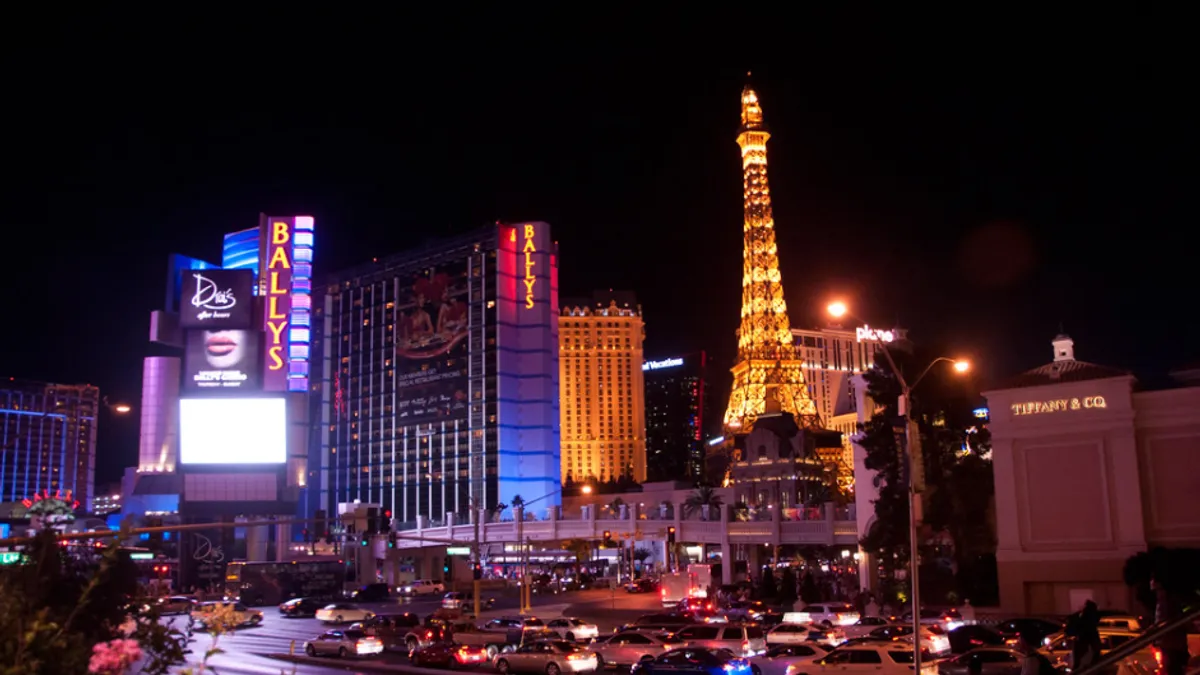Las Vegas relies heavily on entertainment and hospitality to fuel its many big commercial construction projects. Those revenue streams all took a major hit with the onset of COVID-19, which brought a severe halt to travel, dining out, conventions and large gatherings.
Losses in those sectors have begun to affect commercial construction in the region, experts say.
According to the most recent Rider Levett Bucknall crane count index, the number of construction cranes in Las Vegas fell from 17 in the first quarter of this year to four in Q3. Industry watchers are keeping an eye on whether this drop signifies a prolonged slump or just a temporary lag in projects.
Ken Simonson, chief economist for the Associated General Contractors of America, said he looks to the city's struggles during the Great Recession as a cue to how the Nevada area will weather 2020's coronavirus-related challenges.
“I tend to write off Las Vegas too readily,” he said. “It seems to find ways of reinventing itself.”
Simonson said that the Las Vegas area took a severe economic hit from 2006 to 2011 but has since recovered. During that period, the area saw more than double the national average drop in construction employment but came back to nearly its peak. He said he assumes commercial construction in the city will recover again after this pandemic subsides.
But, the economist said, "this might be a riskier assumption because so much of their income depends on conventions, and it’s not clear if convention business will resume even after COVID-19 is held in check."
Megaprojects in full swing
According to Sean Stewart, CEO of the Nevada Contractors Association, several multibillion-dollar projects are winding down as expected this year or early in 2021. Those projects include two large casino hotels — the $4.3 billion Resorts World and the $1 billion Circa Resort and Casino which opened last weekend — as well as an expansion to the Las Vegas Convention Center. In addition, the new Las Vegas Raiders stadium opened this fall.
The completion of these jobs could explain the major crane count drop, he said.
Even if the lower crane count doesn’t indicate trouble in the industry, Stewart said his concern revolves around projects funded by state funds or tax revenue. Those public buildings — University of Nevada Las Vegas developments, for example — that are supposed to begin work soon could fall through.
“My main concern is with public sector where tax revenue is not available to bond against for anticipated projects. I think we’ll feel those losses into 2022,” Stewart said. “The other sector I’m worried about is small retail because those investors will wait to see what will happen with the election and pandemic.”
Loss of gaming income is also a problematic area for commercial contractors. While large corporations, such as MGM Resorts or Caesars Entertainment will weather the loss, smaller companies might not be able to stay afloat until tourism returns to pre-pandemic levels — if it does.
“The smaller casinos are borrowing money to lose money with the goal of gapping the slowdown until they get back to full operations,” said Stewart.
One bright spot reflects a trend seen nationwide in commercial construction, which is the building of warehouses and distribution centers to accommodate the increase in online shopping. Stewart said the Las Vegas area continues to see huge gains in tilt-up concrete facilities used mostly for storage.
Upcoming projects
Stewart said developers don’t seem worried about investing in future projects and he feels optimistic about commercial construction picking up late next year or in 2022. One such project is the Madison Square Garden Sphere which halted construction in April because of supply chain issues resulting from COVID-19 closures.
Work recently resumed on the approximately $1.7 billion arena, which will employ up to 1,500 people for its construction.
“We anticipate a four- to five-month lag in large commercial projects,” Stewart said. “Early next year will be fairly slow, but we’re optimistic that money is in place for future projects and investors are willing to move forward like with the Madison Square Garden arena.”
While investors continue to back several large builds, Stewart said that more than $1 billion of infrastructure work is coming online soon nearby as well. In addition, a large industrial center near Apex, Nevada will require water and sewer along with other utilities.
Daniel Pomfrett, vice president of Los Angeles-based project management and cost consulting firm Cumming Corp., echoes Stewart’s optimism regarding certain commercial sectors for Las Vegas. The increasing residential sector will also boost infrastructure projects, a sector which Pomfrett said is forecast to increase starting next year through 2022.
“Residential will in part drive some commercial growth,” he said, “because communities need infrastructure, schools, hospitals and municipal buildings.”
However, Pomfrett does see a slump in offices, hotels and retail lasting for five or six years before fully bouncing back to 2019 figures. The ripple effects from the pause in project planning will cause the gap Stewart also mentioned and lead to the slow recovery.
“That timeline might be slightly diluted by acceleration of building schedules,” Pomfrett said. “I think around Q3 in 2021 there will be an influx of projects come through and a rise in the market as developers start to get
busy.”




















